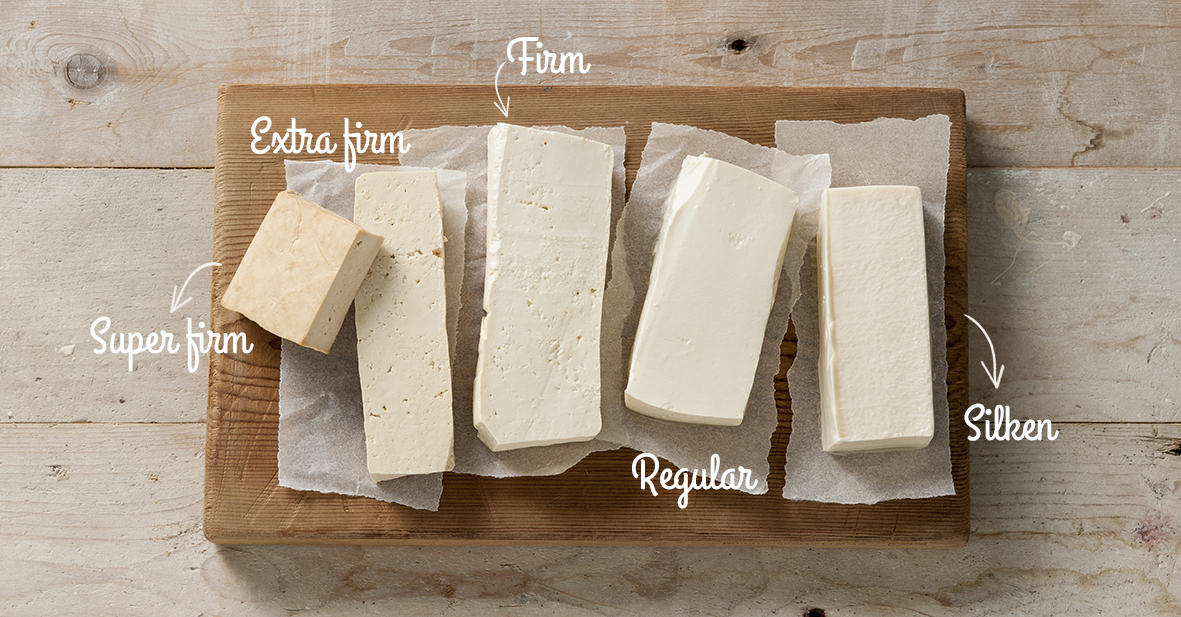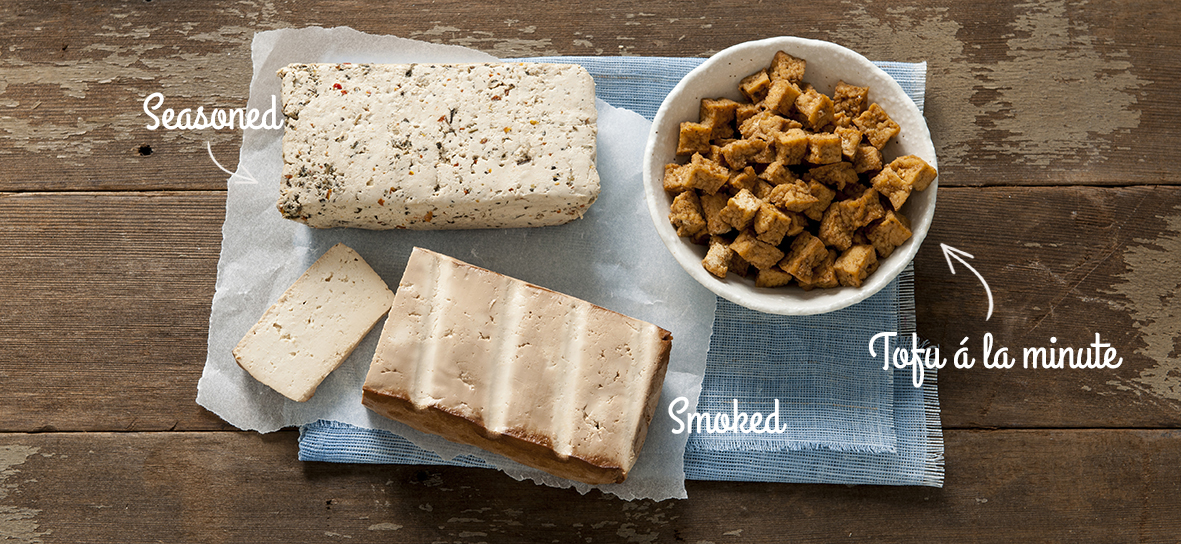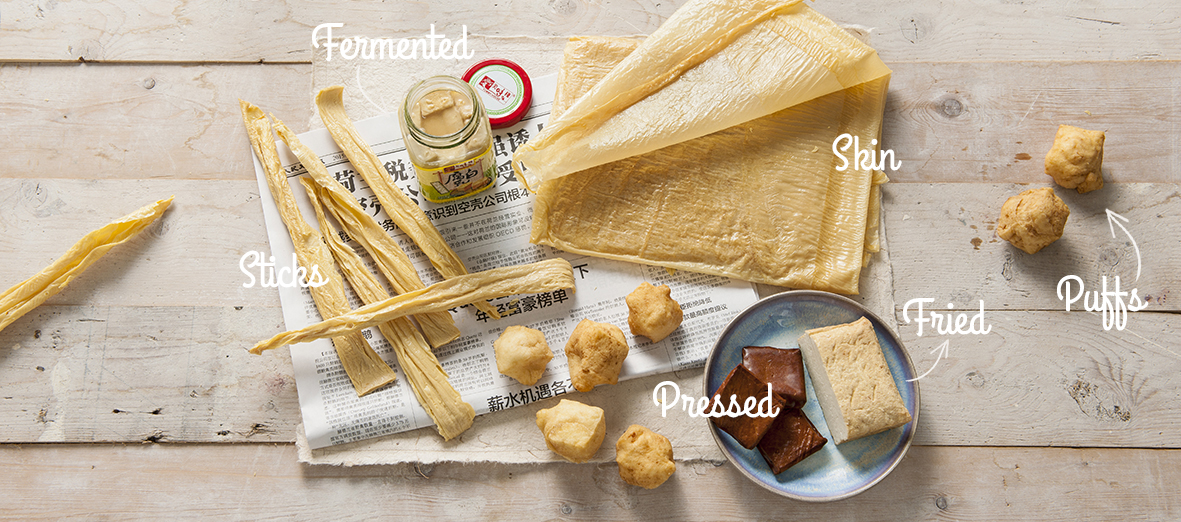Types of tofu
Tofu is categorized by texture, or consistency. The texture is determined by the water content in the tofu. The more water, the softer or ‘silkier’ the tofu; with less water, the tofu is firmer. Tofu is categorized as silken, regular, firm, extra-firm and super-firm. Silken, the softest type of tofu, can be compared to a young white cheese. Firm tofu, the most common, has the same consistency as feta, while the texture of super-firm can be compared to that of meat. You should be able to guess the textures in between.

Silken
Silken tofu, also known as Japanese-style tofu, is silky, creamy and has the highest water content. If you try to hold it, it will fall to pieces. Silken tofu looks like a very young cheese such as burrata (a kind of mozzarella) and can be used as a thick cream, fresh cream cheese or ricotta in cheesecakes, smoothies, dips or even ravioli fillings. You usually prepare dishes with silken tofu when it is wet.
Regular
This type of tofu is used primarily in Asian dishes. It is a little more compact than silken but still soft. Regular tofu easily soaks up the flavours of sauces and broths and so is often used in noodle soups and stews. You can also make delicious spreads using regular tofu, or ‘scrambled’ tofu, a vegetarian take on scrambled eggs. Don’t pan-fry or deep-fry regular tofu as it is likely to crumble.
Firm
Of all the types of tofu, firm tofu is the most widely available in supermarkets. Firm tofu is quite compact and is often packaged soaked in liquid – the amount depends on the type of packaging. Firm tofu is like feta: it doesn’t crumble when you pick it up and it is easy to chop. In the kitchen, firm tofu is the most versatile of the tofu types. It can be pan-fried, stir-fried, deep-fried, put in a stew, used as a filling or to make spreads. Be sure to fully dry firm tofu before cooking, to ensure it can absorb the marinade and will splatter less in the pan. Firm tofu can also be bought smoked or seasoned.
Extra-firm
Extra-firm tofu has less water than firm tofu, which you notice in the difference in texture. The culinary possibilities of firm and extra-firm are almost the same, but extra-firm tofu doesn’t absorb marinades as well. On the other hand, extra-firm is easier to pan-fry, stir-fry or deep-fry. Follow your personal preference.
Super-firm
If you look at super-firm tofu you can easily mistake it for meat because it is so dense. In fact it is a great meat substitute! Cut the tofu into regular-sized slices, sticks or cubes, mix with a hot marinade and pan-fry, stir-fry or deep-fry. Super-firm tofu is not widely available but is easy to make.

Seasoned tofu
Tofu is also available pre-seasoned. This makes it easier to prepare as you can start as soon as you open the packet! Seasoned tofu is available in different flavours; tamari and tomato/basil are widely available. Seasoned tofu is mostly firm and can be pan-fried, stir-fried, deep-fried, grilled, roasted in the oven, barbecued or eaten raw.
Smoked tofu
This tofu is extra-firm and has a smoky flavour. Smoking is generally an artisanal process. Originally, tofu was smoked above tealeaves, but today it is mostly done over beech wood, which gives it a great aroma. You can pan-fry or stir-fry smoked tofu, but it is best eaten raw, such as in a winter stew or a summer salad.
Tofu à la minute
These small tofu pieces are pre-marinated and pre-cooked. All you have to do is add them to a (stir-fry) dish, or pan-fry the tofu à la minute in oil until crispy and add to dishes such as salads and stews. Tofu à la minute can be purchased in a variety of flavours including Asian-spiced, Italian-spiced and Mexican-spiced.

These other tofu products can be found in Asian supermarkets.
Pressed tofu
When tofu is pressed under high pressure, very little water remains, giving it a meat-like texture that can be compared to that of super-firm tofu. There are two types of pressed tofu: natural and pre-seasoned.
Fermented tofu
If you pickle tofu in a mixture of salt, rice wine and water it will ferment. This fermenting gives a tofu deep, savoury flavour called umami. In Chinese cooking, fermented tofu is not used as an ingredient but as flavouring. Don't buy fermented tofu in plastic packaging as only glass stops the fermentation process and so guarantees the flavour.
Tofu skin
When heating soya milk, a skin forms on the surface of the liquid, just as with regular milk. Fresh tofu skins are not widely available, but dried skins are. These skins are similar to filo pastry and can be pan-fried (after marinating), filled and deep-fried like spring rolls, or used to make dim sum.
Tofu sticks
Tofu sticks are sun-dried, rolled tofu skins. Tofu sticks are a great filling for your miso soup.
Fried tofu
These slices of tofu are first firmly pressed and then deep-fried. They are soft and sponge-like and quickly soak up marinades and sauces. In the countries of origin (Japan, China and Korea) you can find two versions: abura-age (oblong slices that are cut into strings and served in soups or over rice) and sushi-age (small squares filled with sushi rice and, as the name suggests, served as sushi). Abura-age and sushi-age taste similar. Fried tofu is usually sold pre-seasoned.
Tofu pockets
Fried tofu is often sold under the name ‘tofu pockets’. First place them for a few minutes into boiling water, then pat dry and cut like an envelope.
Tofu puffs
These tofu balls are frozen first and then deep-fried. They are soft and sponge-like and so ideal for quickly soaking up marinades and sauces. Tofu puffs are already cooked and do not need to be cooked for too long. They are also delicious raw: fill them or dip them into chilli sauce, for example.